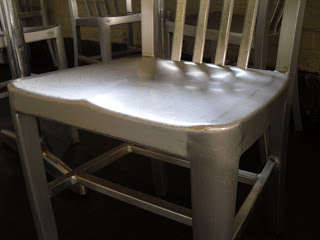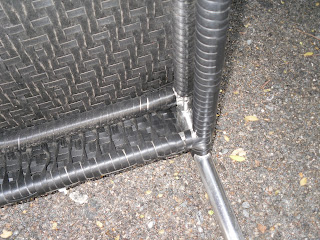Thursday, 31 March 2011
Tuesday, 22 March 2011
RESEARCH PART B: Photos
Chair #1
EXPLODED VIEW
Materials: steel, Processes: welding, forming, polishing
Chair #2
EXPLODED VIEW
Materials: square steel tube, plastic, steel bolts, Processes: bending, welding, drilling, plastic moulding
Chair #3
EXPLODED VIEW
Materials: tubular steel, plastic thread, Processes: metal bending, welding, weaving
Tuesday, 8 March 2011
Production of the D A F Armchair
The design for the swag leg group of chairs began from George Nelson’s simple desire to create a chair with a sculpted leg, seeking practicality and insisting that the legs be made of metal. The innovation for the designs came from the criteria for the design. As well as being curved, the legs needed to be machined formed and pre-finished. The legs use the process of “swaging” whereby pressure is used to taper and curve a metal tube. The result is incredibly strong and organic. Ingenious engineering allows the legs to come together at the base, connected with special screws to the bracket and base of the chair.
The original is moulded fibreglass, but these days the shell of the D A F armchair is made from 100% recyclable polypropylene. The body is 2 separate moulded pieces, glued together under the arm rest, and the result is light and flexes with the sitter. The slit between the 2 pieces prevents heat build-up. The moulding process used is a patented process created by Charles and Ray Eames, and Nelson gained approval to use it. The resulting design appears light and sculptural but is also very strong and durable.
CONTEXTUAL ESSAY: GEORGE NELSON
George Nelson was born in Connecticut in 1908 and is considered one of the founding fathers of American modernism. He graduated Architecture at Yale University in 1928, and completed his Bachelor of Fine Art in 1931. George Nelson was from a generation of Architects who found too few projects and instead turned to other forms of design, including product, graphic and interior design. He was also an influential journalist. He defended the principles of modernist design, much to the irritation of other industrial designers of the time, who he believed made too many concessions to the commercial forces in the industry. By 1940 there was a lot of attention drawn to a number of his popular designs. In 1945 Herman Miller’s President D. J. Du Pree saw one of his innovative concepts, the “storage wall” and offered Nelson the position of Design Director. He set new standards for design involvement in all aspects of the company.
Nelson’s designs were simple and functional. His iconic designs included the coconut chair (1955), the marshmallow sofa (1956) and the swagged leg group of chairs (1958), of which the D A F armchair is a part of.
George Nelson designs: Marshmallow sofa and Coconut chairHe utilised principles of the Bauhaus movement which ‘based its design philosophy on the principles that design should be relevant to the needs of society and that it should utilize modern technology and materials to inexpensively meet consumer needs’ (1) This movement also introduced the use of tubular steel in furniture design. This focus on function resulted in clean, simple, modern design. Similarly, the modernist movement focused on function and involved the introduction of new technologies and manufacturing techniques.
Several of George Nelson’s designs, including the D A F Armchair are still in production today.
Subscribe to:
Comments (Atom)





















































